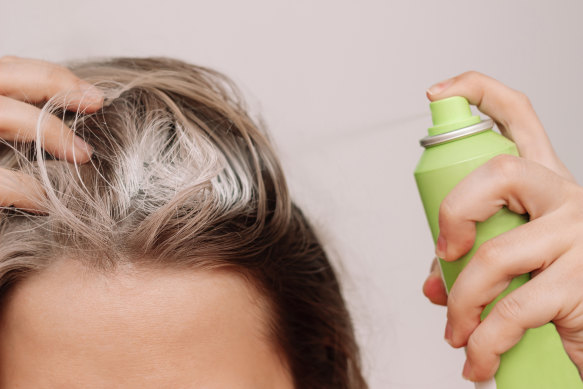I remember a time when French Girl beauty had a chokehold on the culture. French girl hair – perfectly tousled and undone – was a particular obsession, apparently achieved by a combination of irregular hair washing and copious amounts of dry shampoo.
But the recent focus on scalp health has seen some people (mainly influencers on TikTok) turn against products like dry shampoo, claiming it can irritate the skin. Others swore off it completely in November 2022, when a US report found high levels of benzene, a carcinogenic chemical, in many popular dry shampoos.
So, is there still a place for dry shampoo in our hair routines?

Dry shampoo is not an alternative to hair washing.Credit: iStock
What dry shampoo can (and can’t) do
Annette Carter, owner of The Do Salon in Melbourne, says dry shampoo can definitely be part of a healthy hair routine, though it’s not a substitute for washing your hair.
“It’s not magic. If your hair is dirty, your hair is dirty. Dry shampoo is not going to make it look clean,” says Carter. “It’s like cleaning your face – if you don’t wash your face for two days, it’s gross. It’s the same with hair. You don’t want to leave it any longer than [around] three days.”
“Think of it more like an antiperspirant deodorant rather than a shampoo,” agrees Alex Ehsani, managing director of cosmetic formulation company Vida Labs in Sydney. “It’s a more preemptive approach so that the product absorbs oil as it’s produced.”
Charlene Fernandez, a Melbourne-based hairdresser, educator and founder of Reign Salon, says dry shampoo can be a helpful aid when training hair to be less oily.
“When we’re doing training our hair, we need to basically wash the hair less so that we’re not telling the brain there are no oils in there. So what dry shampoo does is it helps to absorb the oil [without stripping it from the scalp] so that you can go about your day feeling not like a grease ball.”
What makes a good dry shampoo?
Many dry shampoos, especially cheaper varieties, contain harsh ingredients that can irritate the scalp and cause buildup, says Carter. When shopping around, she recommends avoiding anything with parabens, PPDs, ammonia or sulfates. Opting for gluten-free products can also be wise, since gluten can irritate many skin types.
Ehsani says to look for natural starches like rice, oat or tapioca that are great at absorbing oil without causing build up. He says minerals like silica and clay are also good, for the same reasons. While alcohol and propellants found in aerosol formulas can irritate, he says if you’re not overusing them you shouldn’t have a problem.
Another important characteristic of a good dry shampoo is the powder itself, explains Fernandez. “What you’re looking for is to have really fine particles. Anything that feels too thick or like it’s coming out of a fire extinguisher is no good. It’s not going to be good for the scalp because it can block the pores of the hair.”
Fernandez says the best dry shampoos should feel weightless. “You don’t want to feel like you’ve put a whole heap of stuff in your hair. What you’re trying to do is reset it rather than put more in.”
So, what about benzene? While carcinogenic, it’s only a concern for chronic, long-term exposure. “This news does not mean any exposure to benzene will cause cancer, which is how people tend to interpret it,” Australian cosmetic chemist and science educator Michelle Wong told The Cut in 2022. “It’s about probability based on the amounts and the exposure – and the risk is really small.”
The difference between aerosol and powder
While aerosols are the most common form of dry shampoo, other formulations like powders and foams are staring to become more common. Ehsani says the choice mainly comes down to personal preference and environmental concerns.
Aerosols, he says, are easier and more convenient to use but contain propellants and alcohols and can be detrimental to the environment.
On the other hand, Ehsani says powder formulas are “gaining popularity for their environmental benefits and potentially healthier scalp effects” due to containing a higher percentage of natural starches that are less irritating, but are more challenging to apply. Fernandez adds that powder formulations also tend to have larger particles, which can be harder to distribute through hair.
How to use dry shampoo
Whether you’re using an aerosol or powder, spray or dust the product from around 30 centimetres away from your head – focusing on the roots and not spraying directly on the scalp – to ensure even distribution and avoid unnecessary buildup.
Carter says she sometimes uses dry shampoo on wet hair, which can help delay oil build up and add a boost of volume once dry. In general, dry shampoo should be applied before hair gets too greasy, at which point it’s probably just due for a wash.
Regardless of whether you’re using a dry shampoo or not, Carter says everyone should be using a clarifying shampoo around once a week to remove any product buildup. Finally, avoid relying on dry shampoo for more than a couple of days before washing your hair.
Make the most of your health, relationships, fitness and nutrition with our Live Well newsletter. Get it in your inbox every Monday.